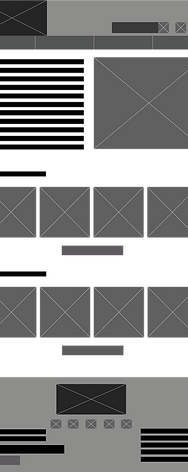.jpg)
Research Stage
I started this project with a group of 2 other teammates. We decided to study other online shopping websites for inspirations and ideas. We study 10 different website to see what's working and what's not working for them, compare them and pick out most interested websites to do in depth study.
After the in depth study of existing websites, we conduct questionare survey and user interview. Using an online questionnaire and interview as a data gathering method to collect insights about pottery interest, experience, and user experience will be helpful in creating an online ceramic e-commerce website that caters to the needs and preferences of pottery enthusiasts. By using the capability of online surveys and interviews, we can capture valuable feedback from individuals with varying levels of interest and experience in pottery, as well as gather insights on user experience to inform the design and functionality of the website.
My main role was to create and run the survey as well as the interviews. We conducted an online questionnaire to gather data about pottery interest, experience, and user experience from our audience. The online questionnaire was published through Google Forms and ran from March 27 to April 4, with a total of 88 respondents. We also conducted interviews with 5 participants to gather insights into their interest, experience, and user journey with pottery. These participants had varying levels of pottery experience, allowing us to collect a range of perspectives and opinions.
Our survey shows that most respondents are aged 18-24, with 54.5% having no pottery experience yet showing high interest in learning. Among those with experience, most are beginners who prefer hand-building techniques. While 72.7% prefer buying ready-made ceramics, 27.3% would rather purchase pottery supplies to create their own. Workshop preferences lean toward at-home DIY kits, though 29% favor a 2-hour studio session. The top interests in the pottery process are making (40.4%) and designing (38.5%), with 93.5% keen on crafting small items. This indicates strong interest in accessible, beginner-friendly pottery experiences.
With the interview results, participants, ranging from beginners to experienced potters, enjoyed the creative process and satisfaction of making pottery. They appreciated the convenience of online shopping for ceramics and supplies, finding platforms generally user-friendly. However, they noted areas for improvement, specifically suggesting clearer product details and more varied imagery to better represent materials and dimensions. While their online shopping experience was positive, they felt that enhanced product descriptions and visuals would improve transparency and overall satisfaction.
.png)
.png)
.png)
After the interview and questionare, we start crafting some personas and activity diagram to understand how user will interact with our website and in what context they will use the website. We have 3 personas along with 3 activity diagram, and each activity diagram have a different context. Below is the persona I have created along with the activity diagram. Personas give insights and guiding design decisions to better meet real user needs while activity diagrams map out the user journey, highlighting efficient pathways and identifying potential friction points.
.png)
.png)
Next thing we considered is Elements to Improve User Experiences. From what we observed through the websites and from our surveys/interviews, we take out some key thing that will be important to the website. The three elements we highlighted is the search bar, the navigation menu and the imagery of the websites. Reasons being:
-
Search Bar: The search bar provides quick access to specific products, especially important in a niche market like pottery, where users might look for unique items. It enhances the shopping experience by allowing users to find exactly what they're looking for without having to browse extensively.
-
Navigation Menu: A clear and organized navigation menu simplifies exploring various product categories, such as "Handmade Pottery," "DIY Kits," or "Pottery Tools." It helps users browse with ease, guiding them through the site's offerings and encouraging them to explore more items.
-
Imagery: High-quality imagery is essential for an online pottery store, as it showcases the craftsmanship and details of each piece. Displaying images from multiple angles and in various lighting gives customers a better sense of the product, building trust and helping them feel confident about their purchase.
.png)
.png)
.png)
At the final stage, we finalise our site map. This structure is decided based on user's journey on the site. Consider key actions like exploring collections, finding specific items, and learning about the pottery process. We also wanted to organize products logically to ensure users can easily browse different pottery types.
Wireframes
Desktop Wireframe





Mobile Wireframe






Prototype
For the prototype, the whole website is not fully functioning yet. However, the main pages which will be used the most has been created to have the most realistic experience. The working pages include: Home Page, Our Products Page, Product Details Page, Cart Page and Order Confirmation Page.